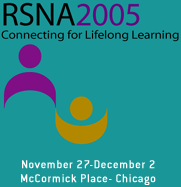
Abstract Archives of the RSNA, 2005
Hans Rosink PhD, Presenter: Nothing to Disclose
Matthieu Visser PhD, Abstract Co-Author: Nothing to Disclose
Nalliah Raman, Abstract Co-Author: Nothing to Disclose
Dimitri Chestakov MS, Abstract Co-Author: Nothing to Disclose
Roos Rajae-Joordens, Abstract Co-Author: Nothing to Disclose
Gerard J. Den Heeten MD, Abstract Co-Author: Nothing to Disclose
To investigate the use of new backlights for medical LCD displays. We will discuss our work on increased brightness, contrast and viewing angle, and their effect on the radiologist’s reading experience.
Brightness increase: a new backlight was developed, raising the peak white of a SXGA monochrome display from 600 Candela/m2 to 2000 Candela/m2. This level is comparable to that of the conventional light box.
In a second prototype LCD display, we drastically improved contrast and viewing angle characteristics. Conventional LCD backlights provide uniform illumination independent of image content (similar to the light box for X-ray film). In our approach, the illumination is adapted to the local image brightness. In this way, an extreme contrast and very deep black level can be achieved, also for large viewing angles.
To study the influence of high brightness, we performed observer experiments, recording the search performance in terms of speed and accuracy on displays with several peak brightness levels (200-2000 Candela /m2). We varied the size and contrast of the artifacts to be detected, as well as the background X-ray image and the ambient light level. In general, we found better performance using the brighter display, in line with previous studies in which the brightness of light boxes with X-ray film was varied.
The second prototype LCD display with improved viewing angle and contrast, was extensively characterized. For normal viewing angle, the contrast was increased from 600 to over 10,000; for large angles (80 degrees off-normal) the contrast increased from 100 to 2,000. We also evaluated the new display by means of a preference test, in which radiologists preferences were recorded for a regular display or the new prototype.
Backlight technology allows drastic improvement in image quality for LCD displays. Our experiments indicate that these improvements have an impact on search accuracy & speed, user preference, user comfort and tolerable light level.
m.v.,H.R.,N.R.,d.C.,R.R.: Employees of Philips Research, Eindhoven, The Netherlands.
Rosink, H,
Visser, M,
Raman, N,
Chestakov, D,
Rajae-Joordens, R,
Den Heeten, G,
Innovation of Medical LCD Displays through Backlight Technology. Radiological Society of North America 2005 Scientific Assembly and Annual Meeting, November 27 - December 2, 2005 ,Chicago IL.
http://archive.rsna.org/2005/4412139.html

